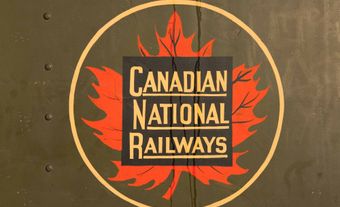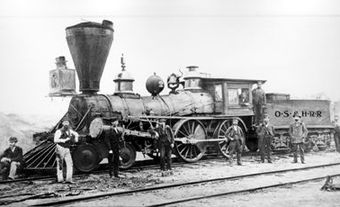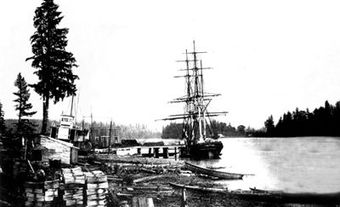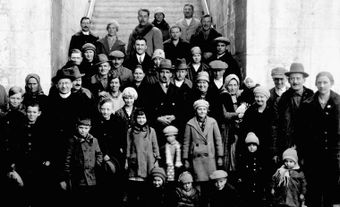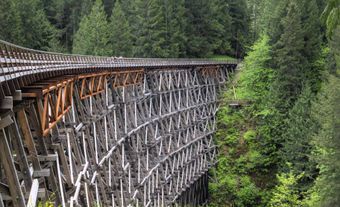The Canadian Northern Railway started as a single Manitoba line of 84 miles (135 km) in 1896. In 1899, the railway received federal charter and was quickly developed by the railway entrepreneurs Sir William Mackenzie and Sir Donald Mann. By 1917, it had expanded to more than 9,000 miles (14,485 km) of track across seven provinces. Originally a major railway network over the Prairie provinces, the Canadian Northern Railway expanded into a transcontinental line with many supporting enterprises, including telegraph and steamship companies. (See also Railway History in Canada.)

Mackenzie, Mann and Company
The history of the Canadian Northern Railway system is inseparable from its creators, Sir William Mackenzie and Sir Donald Mann, along with their two more silent partners, David Blythe Hanna and Zebulon Aiton Lash.
Mackenzie and Mann were two railroad contractors who formed the partnership of Mackenzie, Mann and Company in 1896. Starting with the Lake Manitoba Railway and Canal Company, Mackenzie and Mann set out to construct a sprawling railway network, which they incorporated as the Canadian Northern Railway in 1899. (See also Building the Canadian Northern Railway.) Born to humble beginnings in Kirkfield, Ontario, Mackenzie, as Canadian Northern railway president, looked after finances. Mann, as company vice-president, supervised much of the railway’s construction.

David B. Hanna and Zebulon A. Lash also helped run the company. Hanna was the company’s third vice-president and managed its operations as chief operating officer from the late 1890s until 1919. Lash was the railway’s lawyer, handling the company’s extensive and often complicated legal affairs.
Expansion East and West
The Canadian Northern Railway and its prairie system was created by connecting existing charters granted to or obtained by Sir William Mackenzie and Sir Donald Mann, by constructing new charters and by acquiring rail lines from provincial governments. Most of the charters and lines were absorbed into what would become the railway’s parent company, the Canadian Northern Railway Company. The successful creation of this prairie system was possible through the co-operation of railway partners, the residents of the areas the rail lines served and the various provincial governments that supported the company with subsidies, guarantees and land grants. In return, Mackenzie and Mann accepted a measure of provincial control over freight rates.
When the construction of the Grand Trunk Pacific and the National Transcontinental railway was approved in 1903–04, Canadian Northern was faced with prospective competition in the West and the loss of Grand Trunk traffic in the East. The company made the decision to build its own eastern and Pacific lines to remain competitive.
Subsidiary Companies
To support the railway’s transcontinental expansion, it was necessary for the Canadian Northern to incorporate companies designed to provide supplementary services. These included:
- Terminal, dock, express, bridge, elevator and telegraph companies. The telegraph companies included those formerly operated in Canada by Western Union. (See also Telegraph.)
- Canadian Northern Steamship The steamship company was formed in 1910 for trans-Atlantic service. It used a pair of ships purchased from the Egyptian Mail Steamship Company, the Royal Edward and the Royal George. The ships were requisitioned and repurposed by the military as troop transport vessels at the start of the First World War. A German U-boat sank the Royal Edward on 14 August 1915. The Royal George survived the war but was scrapped in 1922.
- Canadian Northern hotels included the six-storey Prince Arthur hotel in Port Arthur, which opened on 14 March 1911.
- Land and Townsite Companies. One of the most important of the company’s activities related to land. Large quantities of prairie land were acquired from land grants, which the company then sold to assist with the railway's finances. In addition, the Canadian Northern actively encouraged and promoted settlement in order to create rail traffic. As a result, many land companies were created, some with very tenuous connections to the railway. (See also History of Settlement in the Canadian Prairies.)
Did you know?
Canadian Northern created colourful tourist timetable booklets advertising the benefits of travelling by train to the farms of Western Canada. Canadian Northern also created memorable logos, starting with a maple leaf inside a star, which was followed by a classic zigzag pattern.

Financial Difficulties
The large sums of money required to finance the construction of the transcontinental expansion of the Canadian Northern Railway, as well as the earlier prairie lines, was largely obtained by the sale of various forms of securities, many guaranteed by provincial governments or the federal government (see Stock and Bond Markets). In addition, Sir William Mackenzie and Sir Donald Mann, who, besides their railway interests, were entrepreneurs on a worldwide scale, threw their personal resources behind the project. After 1912, international money markets tightened and it became increasingly difficult to dispose of securities, particularly unguaranteed issues.
In 1913, subsidy assistance was obtained from the federal government at the price of transferring a certain amount of capital stock to the Crown. A year later, further stock from some 30 subsidiary companies was demanded as the price of bond guarantees. Thus, by July 1914 the federal government owned 40 per cent of the stock of the consolidated company and had a mortgage on the property.
With the start of the First World War, costs rose and financing became still more difficult. Despite these financial challenges, the track was completed in January 1915 (with a marketing tour in October 1915 and service in November 1915).
Nationalization
Despite the launch of the transcontinental line, the company's financial difficulties increased. Appeals for aid from various railway companies inspired the appointment of a Royal Commission to investigate the Canadian railway situation. The commission recommended that the Government acquire the Canadian Northern system.
Under an agreement, signed 1 October 1917, the Dominion government obtained additional shares of Canadian Northern capital stock amounting to nearly 60 per cent of the total, at a price to be determined by arbitration. A board of arbitration sat from January to May 1918 to determine the value of the shares. With the acquisition of these shares by the government, the railway was nationalized and most of the board of directors resigned on 6 September 1918. The new board, headed by D.B. Hanna, former superintendent, took over operation of all government-owned railways. (See also Railway History in Canada.)

 Share on Facebook
Share on Facebook Share on X
Share on X Share by Email
Share by Email Share on Google Classroom
Share on Google Classroom


